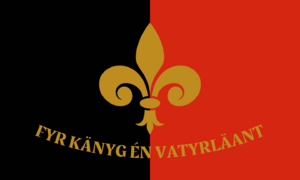Volunteer Army of the Just King (Pacifica)
| Volunteer Army of the Just King | |
|---|---|
| Friwillige Armee da Reekts Kanigs | |
 Flag of the FARK | |
| Founded | 1904 |
| Disbanded | 1994 |
| Allegiance | |
| Type | Paramilitary |
| Size | 15,000 |
| Motto(s) | Fer Kanig ond Vatreland (For King and Fatherland) |
| March | Wissar Faalke (White Falcon) |
| Engagements | Insurgency in the Kleinhart Jura
War of 1919 Weissersteiner Civil War Clashonian Civil War 1994 Clashonian War |
| Commanders | |
| 1st Commander | Gothart Brent |
| 2nd Commander | Ernst Kopland |
| 3rd Commander | Julian Hiršl |
| 4th Commander | Oliver Kipping |
| 5th Commander | Adrian ven Heyden |
The Volunteer Army of the Just King (Clashonian: Friwillige Armee da Reekts Kanigs: FARK), also known as the Royal Clashonian Army in Bannarsia and as the 2nd Corps of the Royal Clashonian Army-in-exile, was a far-right, radical monarchist paramilitary force that operated in Clashonia and Weisserstein. Founded in 1904 on the wake of the Unionist coup d'etat, FARK conducted attacks against the Union State and the Republic in hopes of reinstating the Clashonian monarchy. Their methods includes guerilla warfare, open war, and terrorism. Following the monarchy's restoration, FARK dissolved and was succeeded in the political arena by the Royalist Communion. The force took its name from an essay by Clashonian monarchist writer Erick Ernst ven Voller.
In May 1904, members of the Party of the Union State launched a coup d'etat against the Clashonian monarchy. King Williem II and his family were exiled and sought refuge in Weisserstein. Several prominent supporters of the monarchy would also fled at this time, namely pro-monarchist writer Erick Ernst ven Voller. He wrote in an essay 2 weeks after the coup, titled "The Just King and those who removed him." This essay attempted to frame the Unionist movement as an evil force, removing the Just King, in this period Williem II, from power through evil means.
In June 1904, former Major General Gothard Brent organized a small, private militia force, whose goal was to reinstate the Clashonian monarchy. It was partly funded by von Voller, and so the organization was named after his essay. After it was founded, the FARK immediately became involved in an insurgency in the Kleinhart Jura alongside another pro-monarchy militia, Kanigsbrigad Oltmann. It would absorb the latter in 1909, as the insurgency was seemingly defeated and FARK retreated to the interior of the Kleinhart Jura. In 1917, FARK was consolidated into the reestablished Royal Clashonia Army, alongside other paramiitaries such as the Royal Volunteer Legion and the Kristian Sorrum Brigade. FARK would be involved during the War of 1919 and fought alongside the Reichswehr in the Kleinhart Jura, successfully pushed nearly 1,180 km inland and were right outside the city of Friweel before the signing of the Treaty of Bernborg. Despite their victory, FARK was only partially able to reinstate the monarchy with the reestablishment of the Grand Duchy of Bannarsia in 1926.
After the establishment of the Clashonian Republic, FARK continued its guerilla operations in the Kleinhart Jura, and began gaining sympathy from many Clashonians. FARK became involved in the Weissersteiner Civil War on the side of the monarchy and was involved in numerous battles. In the aftermath of the Weisserstener Civil War, it would continue its operations against the Clashonian Republic until the Republican Guard launched a coup against the government in 1951, beginning the Clashonian Civil War. In the aftermath of the Clashonian Civil War, General Šummaker's junta government issued a decree, designating FARK and other monarchist movements in Clashonia as enemies of the state, and began a crackdown campaign against the royalists. FARK would continue its insurgency, and even launched a coup attempt against Šummaker codenamed Operation Sunfall, though this would fall short. After this attempt, the Clashonian Army would launch a massive counterinsurgency campaign once again, this time with the goal of completely destroying FARK, codenamed Operation Vengeful, which failed to completely destroy FARK and its leadership.
FARK would become notable once again following the coup against President Kleyn in 1993 by the Clashonian military. In the chaos of a second junta, FARK membership skyrocketed as the people protested the coup, making FARK one of the most powerful opposition militia in Clashonian history. In 1994, FARK would launch a massive operation, capturing parts of northern Bannarsia and were closing in on Williemsbode. FARK would later free President Kleyn during April. Many members of the Clashonian military defected and joined forces with both FARK and the exiled portions of the military to rebuild the Royal Clashonian Army in May, which would successfully liberate Karlsbode in July and saw the surrender of General Saawer, marking the end of the Clashonian Republic. On August 21, a nation-wide referendum was held on whether or not Clashonia should reestablish the monarchy. Results would come in on August 27, with 61% voting in favor and 33% voting against. This would see the Clashonian monarchy reinstated on August 28.
Name
History
1904 - 1922
Insurgency in the Kleinhart Jura
War of 1919
1922 - 1953
Insurgency against the First Clashonian Republic
Weissersteiner Civil War
Clashonian Civil War
1953 - 1994
Insurgency against the Second Clashonian Republic
Operation Sunfall
Operation Vengeful and further crackdown
1993 Clashonian coup d'etat
1994 Clashonian War
Organizational structure
Legacy
After the restoration of the Clashonian monarchy, FARK was officially disbanded in a formal ceremony. Several members of FARK, such as its last commander Adrian ven Heyden, wanted to continue the royalist struggle in the political arena. This led to the founding of the Royalist Communion, a political party within the Landtag.